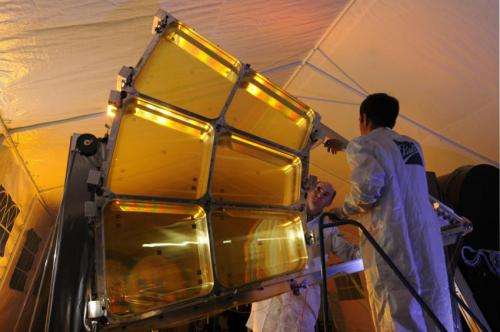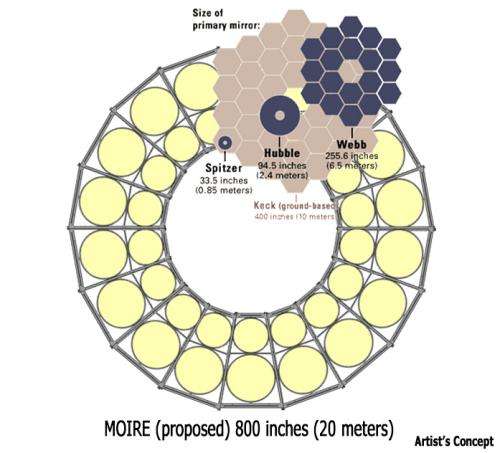April 23, 2014 weblog
Telescope tech using membrane optics moves to Phase 2

(Phys.org) —The United States military's advanced research arm (Defense Advanced Research Projects Agency, or DARPA) never bored with the topic of finding smaller, less expensive launch vehicles, is now in Phase 2 of a program called MOIRE. The program is for creating first-ever images using lightweight membrane optics. MOIRE could help redefine how orbital telescopes are built, launched and used. MOIRE stands for the Membrane Optical Imager for Real-Time Exploitation. DARPA said, "MOIRE aims to create technologies that would enable future high-resolution orbital telescopes to provide real-time video and images of the Earth from Geosynchronous Earth Orbit (GEO)—roughly 22,000 miles above the planet's surface." This would be a step forward; size and cost constraints have prevented placing large-scale imaging satellites in GEO.
The vision involves orbital telescopes much lighter, more transportable and more cost-effective. Membrane optics are key to the effort, enabling much larger, higher-resolution telescopes to be fit in smaller and lighter packages. Lt. Col. Larry Gunn, program manager, commented that "In that respect, we're 'breaking the glass ceiling' that traditional materials impose on optics design."
Instead of using traditional glass mirrors or lenses, MOIRE seeks to diffract light with Fresnel lenses made from a lightweight membrane. How lightweight? It is roughly the thickness of household plastic wrap. MOIRE would house the membranes in thin metal "petals" that would launch in a tightly packed configuration. In reaching its destination orbit, the satellite would unfold the petals to create the full-size multi-lens optics. The envisioned diameter of 20 meters would be "the largest telescope optics ever made and dwarf the glass mirrors contained in the world's most famous telescopes," according to DARPA.
DARPA's interest in technology of this nature is also reflected in a statement that, "To meet national security requirements around the world, it would be optimal to have real-time images and video of any place on earth at any time—a capability that doesn't currently exist."
Aircraft are currently used to meet much of the imagery requirements, but spacecraft also plays a vital role in providing the imagery data needed, said DARPA, and spacecraft faces challenges. "The size (aperture) of the optics needed, and the limitations of producing and launching extremely large precision reflective (mirror) optics means it is infeasible to place such a system in geosynchronous earth orbit (GEO), approximately 36,000 kilometers high, where it could provide persistent coverage." That is where MOIRE comes in, to address the challenge.

DARPA also outlined how far they have come and the work ahead. The MOIRE program began in March 2010 and encompasses two phases The MOIRE program completed Phase 1 in September 2011 and is in Phase 2. Phase 1 verified the proof of concept for the program design. Phase 2 seeks to reduce many of the risks involved in using diffractive optics for space imaging systems. DARPA said, "As part of Phase 2 technology risk reduction, MOIRE plans to perform an on-orbit experiment of optical membrane imaging technologies through the United States Air Force Academy's FalconSAT-7 program."
More information:
www.darpa.mil/Our_Work/TTO/Pro … itation_(MOIRE).aspx
www.darpa.mil/NewsEvents/Releases/2013/12/05.aspx
© 2014 Phys.org




















